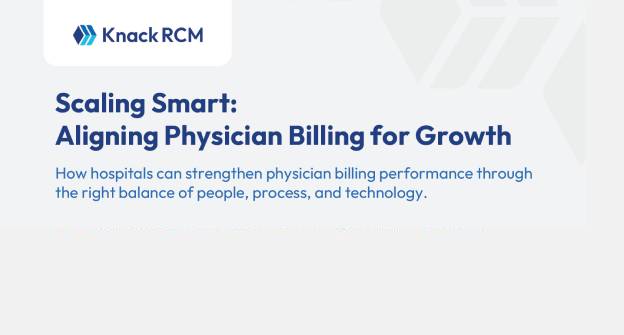Margin Matters – How Smarter Revenue Cycle Management Strengthens Cost Containment

According to the Medical Group Management Association (MGMA), 41% of medical practices cite margin and cost containment as their top priority. Rising labor costs, supply inflation, and stagnant reimbursement—particularly in Medicaid, where payments lag behind Medicare rates, according to the Medicaid and CHIP Payment and Access Commission—have left physician groups squeezed from all sides.
Whether independent or hospital-owned, practices face shrinking margins and mounting pressure to deliver more with less. Yet amid these constraints, one of the most underutilized levers remains within reach: the revenue cycle. When optimized, revenue cycle management (RCM) contains costs, accelerates cash flow, and protects margins.
The Margin Challenge in Today’s Market
Independent practices often operate lean by necessity, leaving little room for inefficiencies. Hospital-owned groups, on the other hand, face higher overhead and the burden of navigating system-wide complexities. In both settings, even minor breakdowns in billing or workflow can cascade into costly errors downstream.
Current reimbursement models trail far behind skyrocketing expenses. Kaiser Family Foundation (KFF) data shows physician payments under Medicare’s fee schedule have stagnated despite inflation. According to the American Hospital Association (AHA), hospitals were reimbursed just 83 cents on the dollar for Medicare patients in 2023, contributing to $130 billion in underpayments from Medicare and Medicaid combined.
RCM’s Role in Margin Protection
A strong revenue cycle strategy can stabilize cash flow and reduce unnecessary costs. Key levers include:
- Accounts Receivable (A/R) Management: Faster follow-up reduces A/R days and lowers the risk of bad debt write-offs.
- Cash Acceleration: Clean claims, denial prevention, and timely resubmissions keep revenue flowing, reducing delays.
- Cost to Collect: Outsourcing to global RCM teams lowers overhead compared to the higher fixed costs of in-house staff.
Broader Cost Wins Through Smarter RCM
Many providers overlook revenue opportunities by focusing only on common variance reports. The most effective modern RCM goes beyond collections, capturing hidden losses and unlocking savings, such as:
- Tech Without Capital Spend: Accessing automation and analytics without upfront investment.
- Denial Prevention: Reducing rework and the labor costs of fixing avoidable errors.
- Payer Negotiation Support: Improved RCM data identifies underpayments and informs smarter contract decisions.
- Scalable Staffing Models: Flexible support teams adjust to demand, minimizing idle labor and over-hiring.
Why a Global RCM Partner Makes Sense
Partnering with a scalable RCM team brings specialty-trained billing talent from day one, reducing onboarding demands and reducing errors. With predictable fees, RCM partners stabilize costs by replacing in-house staff expenses, like overtime, turnover, and recruitment, with a consistent solution aligned to claim volumes. Knack RCM also delivers measurable improvements in collections and payer yield, making it easier to preserve margins while scaling sustainably.
Final Takeaway
Though margin pressure isn’t easing anytime soon, your revenue cycle can serve as a powerful line of defense.
In today’s environment, marked by rising costs and stagnant reimbursement, a high-performing RCM strategy is one of the most effective ways to protect your practice’s long-term financial health. By focusing on cash acceleration, denial prevention, efficient A/R management, and scalable support, RCM can help build lasting financial resilience.
Recent Posts

Scaling Smart: Aligning Physician Billing for Growth
Read More
Scaling Without Breaking: How to Strengthen Physician Billing as Your Network Grows
Read More
From Overhead to Opportunity: Structuring RCM Teams for Hospital-Owned Success
Read More